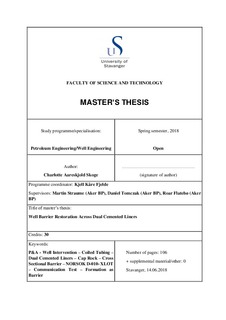| dc.description.abstract | In the past years there has been an increased focus on decommissioning of wells in the NCS. Decommissioning of wells introduces significant investments with no financial returns and has for those reasons historically had less focus. The expected large cost of Plug and Abandonment (P&A) is a massive expense for the license holders, the State, and Norwegian tax payers who contribute with 78% of the total sum of P&A [1]. A reduction of these costs could therefore be considered an advantage for all contributors. Optimizing already existing technology and introducing new methods of performing P&A operations, such as rigless P&A, may therefore contribute in making P&A more economically sustainable.
Cement Bond Log (CBL) is the commonly used tool for verifying external barriers downhole in a well. This has proven to be challenging because two casing strings must be set to obtain an acceptable barrier for production as per requirements. Today’s CBL tools are not capable of logging through two casing strings. To get an adequate signal response from the CBL, one would have to mill or cut and pull the inner casing, and pull the tubing, which is normally done using a rig. The industry is lacking the technology to verify barriers for P&A purposes through two casing strings, owing to insufficient logging tool capability. There is a demand for a method to establish well barriers without logging, preferably rigless which would save cost.
The main purpose of this thesis is to document and share the knowledge and experiences obtained from a suggested approach of barrier restoration first performed by Aker BP in 2017. The idea was to perforate zones and perform pressure tests through perforations, to establish communication to the formation outside the outer casing, and thereby verify barriers downhole for P&A purposes. The operation was performed rigless by using Coiled Tubing (CT). The thesis will view whether this technology could be an alternative to the CBL and still be feasible and fulfil the requirements defined in NORSOK D-010.
Results from the case study form an adequate basis to consider eliminating the conventional CBL tool where two casing strings exist. The evaluated method is sufficient to identify hydraulic sealing intervals, and by using the proposed method, the barrier requirements given in NORSOK D-010 were achieved. The method introduced economic benefits because there was no need to cut and pull the inner casing in order to log the cement outside the outer casing. Aker BP also estimated that the use of CT was six times cheaper than using a rig [2]. Finally, both the Christmas Tree (XMT) and CT Blow Out Preventer (BOP) were rigged up all the time resulting in a very safe operation, hence reducing HSE risks [3]. | nb_NO |
